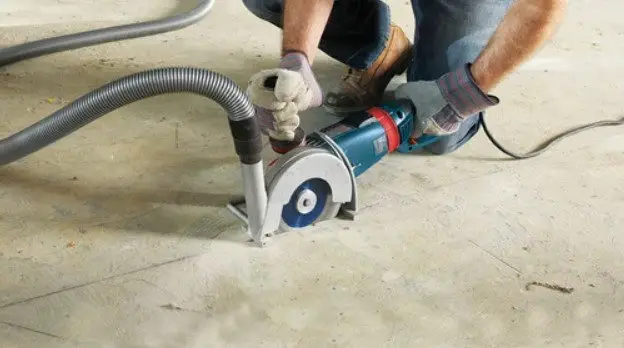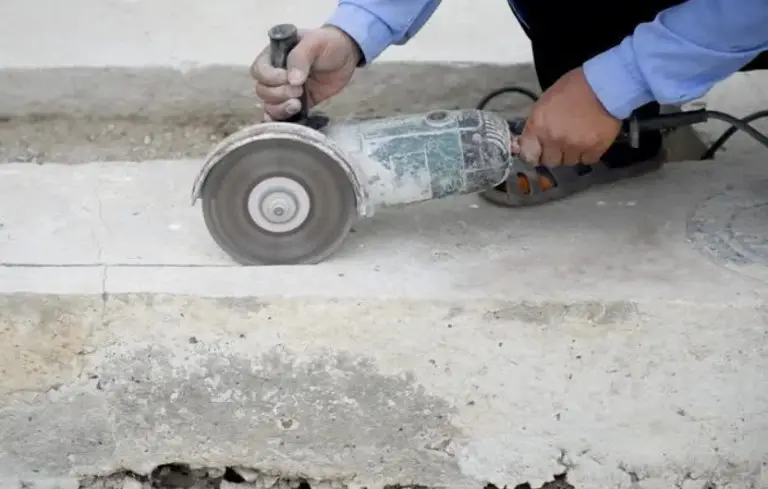Cutting concrete & masonry materials such as bricks, marble stone… is one of the most common uses of angle grinders. However, many factors must be considered to guarantee your safety and efficiency when using power tools like them. Below are some pointers for cutting concrete with an angle grinder.
Contents
What To Prepare Before Cutting Concrete With An Angle Grinder?
Safety Gear
Whenever you carry out concrete cutting projects, you should wear eye, ear, and respiratory protection gear, especially during dry-cutting.
- Before starting to cut, ensure that your angle grinder’s safety guard is in position and secured.
- Don’t wear loose clothes & put on gloves to safeguard your hands and improve your grip. During the concrete cutting projects, small pieces of the tough materials can break and fly off, posing a serious hazard.
- Protect your eyes with a pair of goggles to avoid getting particles. It’s also a good idea to put on a full-face mask to avoid inhaling any concrete dust.
Angle Grinder Blade For Concrete

The best type of grinder disc for concrete is a diamond blade. Both wet and dry cutting wheels can be used to cut concrete. However, wet blades need water and this requirement is difficult due to the lack of wet cutting angle grinders.
Based on the blade’s rim, there are 3 types of dry-cutting diamond blades.
- Segmented blade
A toothed rim helps a segmented disc to eject dust and cool its blade with air movement. Overheating, which damages the bond and can deform the blade, is one of the threats to its lifetime.
Angle grinders are primarily equipped with segmented diamond blades to cut limestone, concrete pavers, reinforced concrete, concrete blocks, masonry, and brick.
- Turbo blade
Unlike segmented wheels, turbo blades are specifically manufactured to achieve a faster cutting speed for dry & wet cutting. To cool the grinder’s blade, the turbo rim allows air to pass via its smaller turbo portions.
The little holes strewn across the turbo blades are also intended to improve cooling capacity. Furthermore, the turbo segments’ angle is designed to assist in pushing the material out.
This type of blade is good at cutting concrete, limestone, and brick effectively.
- Continuous rim blade
These blades are utilized to cut marble, ceramic tile, granite and porcelain tile. Continuous rim blades are the best choice for wet cutting. However, they are not the first choice when it comes to cutting concrete.
How To Cut Concrete With An Angle Grinder?

After choosing the most suitable concrete cutting disc and wearing protective gear, start your project in the following order.
Step 1. Mark The Concrete
Use a tape measure and a pencil to plan the cut on your concrete object.
Then, use a carpenter’s square to draw straight lines on the surface of the concrete object at the measurement markings.
Step 2. Turn On The Grinder
Turn on your angle grinder. When you are cutting, the grinder’s disc will push debris back to the handle and the tool user.
Therefore, you should position the power tool’s wheel outward and its guard upward. If the tool falls or binds during cutting, the wheel will roll the tool away from you, guaranteeing your safety.
Step 3. Score The Concrete
Score the concrete’s surface following the marked lines in step 1, using your angle grinders’ wheel.
Cut the concrete back & forth along the pencil marks until a ⅛-inch groove in depth is formed. This process should be repeated for each pencil line.
Step 4. Do The Actual Cut
Use your grinder to cut through the concrete following the score marks. If you cut completely across the surface, you should cut the outer edges of a straight line before its center.
By contrast, push your grinder disc through each score mark’s center if you cut a hole in your concrete workpiece’s center. Work the disc to the hole’s corners once it has penetrated the center of the score markings.
Step 5. Finish The Trims
Turn your concrete object over. Use your angle grinder to work on its reverse side, finishing the corner cuts and trimming excess concrete. By trimming from the back of the concrete workpiece, you can protect its visible surface.
Other Techniques Of Cutting Concrete
The aforementioned steps are the standard process to cut concrete. However, if the objects that you are working on have rebar, concrete slabs, or blocks, you should pay more attention to your techniques.
For Concrete Contains Rebar
Cutting through rebar-encased concrete is more complex than cutting through plain concrete. In this case, the finest option is still the diamond cutting wheels.
Ensure to utilize a new blade because the steel of the rebar will wear down your blade’s diamond edge faster than concrete alone will.
Cutting concrete that contains rebar is not for the inexperienced because it is designed to be incredibly strong and requires a lot of force to be cut through. Make sure that you measure where you’re cutting and stay clear of any conduits and utilities that are hidden beneath the concrete.
For Concrete Slabs Without Rebar
In this case, you’ll need to make multiple cuts through them. Once you have made cuts of a few inches into your concrete slabs, you’ll chisel or smash the excess concrete you wish to remove. Then, keep cutting until you’ve gone all the way through.
For Concrete Slabs Of Gas Line, Drainage Pipe, Etc.
To install new drainage pipes or gas lines inside a garage or home, you may need to cut old concrete slabs below the flooring. With an angle grinder, you can carve a recessed passage in the current concrete foundation that is just broad and deep enough for the pipes to lay in.
It is critical not to damage any other utilities which may be present in the concrete slabs.
FAQs
1. Can I Use Metal Blades To Cut Concrete?
Metal discs can make shallow cuts on concrete. Nevertheless, they don’t perform as well as their diamond counterparts.
As their name suggests, metal blades are more suitable for grinding and cutting metals. By contrast, when they are utilized on concrete, metal wheels will make slower cuts, which leads to lower overall effectiveness.
2. How Deep Can An Angle Grinder Cut Through Concrete?
A 4.5-inch power tool can cut through a concrete object of up to 1 inch in thickness. However, the same concrete cutting job may be completed quicker and more precisely with its 9-inch counterpart. The maximum depth that the bigger angle grinder can cut through is from 3 to 3.5 inches.
Check more: How To Cut Asphalt With An Angle Grinder?
Final Words
To cut concrete more efficiently, you should choose the best angle grinder with diamond blades. Another important aspect when you carry out concrete-cutting tasks is your safety. By following our step-by-step guide and safety tips, we believe that you can accomplish these tasks both effectively and safely.

